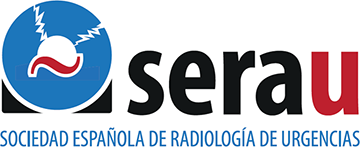Hospital: Hospital Clínico Universitario de Valencia.
Nº: C2019-109
Aut@r o Autores: H. Chicote, C. Parrilla, M. De La Cruz, S. Busó, M. Aparisi, J. Mogort.
Presentación
8 year-old male who suffered a direct contusion on the left groin after falling on the handlebar of his bike. The patient did have no pain but coldness and weakness of distal pulses of the left inferior limb. Arterial Doppler sonography and CT angiography of the left limb demonstrated an occlusion of the left common femoral artery secondary to closed trauma.
Discusión
The findings of absence of Doppler signal and weak arterial flow in ultrasound are compatible with acute thrombosis of the common femoral artery, being confirmed in the CT angiography, as an absence of contrast in the same segment, caused by a closed trauma. Acute arterial injuries due to trauma are more frequent after a penetrating trauma that causes direct arterial damage. In the case of closed traumas, they are usually associated with bone fractures, whose fragments damage the arterial wall. Arterial thrombosis after a closed traumatism without underlying bone fracture is very rare, being the mechanism of production secondary to the compression and sudden decompression of the artery against adjacent bone structures, causing thrombosis due to focal damage of the arterial intima (the innermost layer of an artery). Typically this kind of situation has been described after a bicycle accident where the handlebar hits and abruptly compresses the inguinal region against pelvic bones. The symptomatology of ischemia is usually subacute, which, together with the absence of bone lesions, causes the diagnosis to be delayed. The symptoms of pain and other signs and symptoms of severe arterial ischemia will occur weeks or even months after the trauma. The diagnosis is based fundamentally in the absence of arterial pulses and coldness of the limb associated with skin lesions.Treatment remains controversial, especially in childhood. Primary repair of arterial injuries must be the election treatment when possible. When grafting is required, the use of autologous grafts is preferable to synthetic ones. In children, there are no studies that support different types of treatment. In our case, we proceeded to perform an autologous venous graft with contralateral greater saphenous vein, evolving favorably.
Conclusión
Acute common femoral artery thrombosis due to closed is rare but should be considered a direct contusion with a bike handlebar. Doppler ultrasonography can be used as the initial approach in case of suspected arterial injury, and it should be always completed with a CT angiography for final diagnosis.
Bibliografía
Taneva, GT, Arribas AB, Baeza C, Aparicio C, González A. Complete femoral artery transection following handlebar trauma. Trauma Case Reports, June 2015, 9, 1-4. Byun CS, Park IH, Do HJ, Bae KS, Oh JH. Left External Iliac and Common Femoral Artery Occlusion Following Blunt Abdominal Trauma without Associated Bone Injury. Korean J Thorac Cardiovasc Surg. 2015,48(3):214-6.


